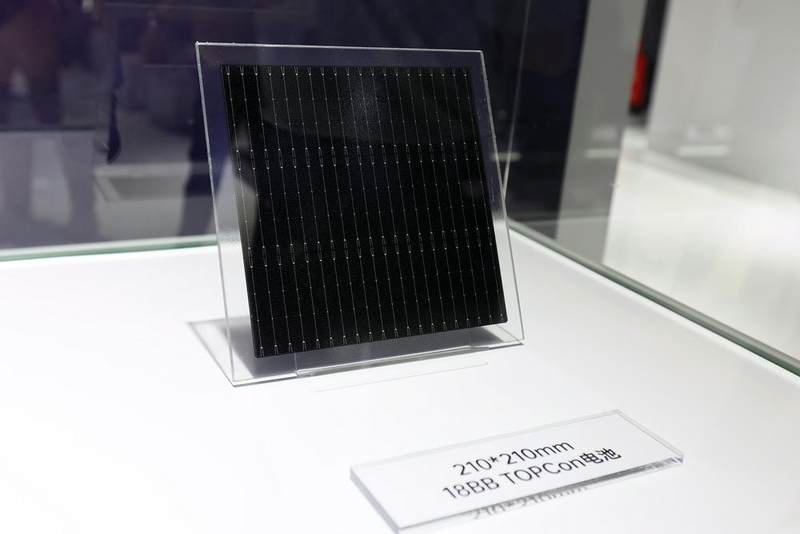“With one iteration of technology, the market share has undergone huge changes. If the company does not keep up, it means losing the market.”
Patent litigation by photovoltaic giant resurfaces, and the contradiction still lies in TOPCon cell technology

Photo source: Visual China
Blue Whale News February 13 (Reporter Cui Lupeng) Recently, Trina Solar, a leading photovoltaic company, issued an announcement stating that the court has filed a lawsuit filed by the company against two suspected patent infringements by Ates and its subsidiaries, demanding a total compensation of 1.058 billion yuan. This amount also set the highest litigation among domestic photovoltaic companies.
On February 11, Ates issued an announcement in response stating that the company had conducted sufficient research and analysis on the two patents involved in the case of Trina Solar and believed that there was strong evidence to prove that the two patents should be invalid, and the company’s products and processes do not infringe on the two patents.
It is worth noting that this lawsuit still revolves around TOPCon battery chips. According to Trina Solar’s announcement, patent 1 (ZL201710975923.2) involves solar cell modules, and patent 2 (ZL201510892086.8) involves solar cells and their manufacturing methods.
In addition to this issue of litigation, Blue Whale News does not fully count that in the past year, including multiple lawsuits filed by Trina Solar, the lawsuit filed by Jingao Technology against Chint Xinneng, and the mutual lawsuit between Jingke and LONGi, all involving TOPCon battery chips.
“Several patent lawsuits have been launched around N-type technology, also because the market share of this type of product has increased sharply in the past two years.& rdquo; The market leader of a leading photovoltaic module company told Blue Whale News that P-type batteries occupied the market earlier than N-type batteries and became mainstream.
TOPCon cell is a high-efficiency solar cell that has the advantages of reducing warping and bending of the cell substrate and improving cell production efficiency. According to Jibang Consulting’s previous forecast, by the end of 2024, the total production capacity of photovoltaic cells will be approximately 1417GW, of which the production capacity of N-type cells will be approximately 1078GW, accounting for approximately 76%; among all N-type production capacity, TOPCon battery production capacity is approximately 941GW, accounting for approximately 66.4% of the total production capacity.
According to InfoLink statistics, the P-type battery market will still account for 88% in 2022, and the total proportion of N-type battery chips will only be 9%. In just two years, N-type batteries have gradually replaced P-type batteries and become the mainstream.
“Compared with the P-type, TOPCon is more efficient and the cost is still decreasing. It is the most cost-effective technology route at this stage. rdquo;According to the above-mentioned person in charge, TOPCon technology and PERC technology belong to high-temperature processes. Previously, domestic manufacturers ‘production capacity was mainly P-type technology, which enabled most PERC manufacturers to maintain the existing p-type battery equipment process and achieve lower iteration cost upgrades to TOPCon technology.
“TOPCon is a technical direction with many specific patents.& rdquo; Another person in charge of a photovoltaic company revealed that as far as he knew, domestic manufacturers mainly began to study this technical route around 2020. Previously, most of them were Japanese and Korean companies.
In 2022, LG Group announced its complete withdrawal from the photovoltaic manufacturing industry. In September of the same year, LG Group transferred a batch of patents to Shangrao Xinyuan Yuedong Technology Development Co., Ltd., a subsidiary of Jinko Energy.
According to industry media “Chasing Carbon”, the Smart Bud Data Platform shows that LG Group has transferred a total of 745 patents to Jinko, covering countries and regions including the United States, South Korea, Germany, China, Australia and Europe. These patents are all invention patents. Among them, 705 were authorized patents, and another 40 were still under review.
In March 2024, Jingke successively transferred some patents to Trina Solar and Jingao Technology. According to incomplete statistics from Blue Whale News, as of January, Jinko Energy had 462 patents related to TOPCon and Trina Solar had nearly 370 patents.
“With one iteration of technology, the market share has undergone tremendous changes. If the company does not keep up, it means losing the market. rdquo;According to the above-mentioned market leader, in recent procurement projects where component models have been clarified, there is almost no demand for bidding and procurement of P-type components.
However, companies with technological advantages have not opened up the market gap with the companies behind them in the short term.“This means that the technology dividend period is also shortening. Companies have to invest heavily in research and development and also need to survive in the price war. rdquo;The person in charge said that when the market is large enough, companies pay less attention to intellectual property rights, but in the past two years, market competition has become more intense, and companies have paid more attention to patents, which is also a means of competition.
On February 13, another dispute over infringement of invention patents between Shangrao Xinyuan Yuedong Technology Development Co., Ltd.(Jingke Energy Subsidiary), which has attracted much attention in the industry, and Jiangxi Shangwei Technology Co., Ltd. and LONGi Green Energy Technology Co., Ltd., will be held in the first instance of the Intermediate People’s Court of Nanchang City, Jiangxi Province.
According to the above-mentioned person in charge, in recent years, companies have regarded technological innovation as an important means to enhance competitiveness. With the continuous development of photovoltaic technology and the continuous expansion of the market, the competition for photovoltaic patents will become increasingly fierce.



